Americans with Disabilities Act 25th Anniversary Timeline - Disability & Employment
Americans with Disabilities Act 25th Anniversary Timeline
Disability & Employment:
A Timeline
________________________________________________________________
Commemorating 25 Years of the Americans with Disabilities Act
The Smith-Fess Act
________________________________________________________________
6/2/1920
Signed into law by President Woodrow Wilson, the Smith-Fess Act (also known as the Civilian Vocational Rehabilitation Act) establishes the Vocational Rehabilitation program for Americans with disabilities. It is modeled on an earlier law that provided for the rehabilitation of World War I veterans with disabilities. At this point, only individuals with physical disabilities are eligible for services.
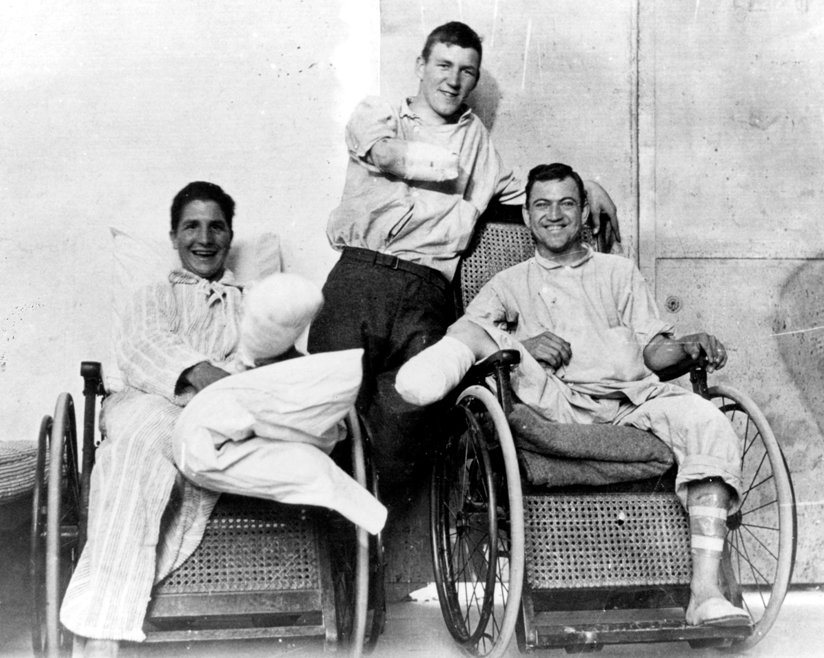
American World War I veterans. — National Library of Medicine
Works Progress Administration Protests
________________________________________________________________
1935
A group in New York City called the League for the Physically Handicapped forms to protest discrimination by the Works Progress Administration (WPA). The league's 300 people—most living with polio and cerebral palsy—had all been turned down for WPA jobs after the city’s Home Relief Bureau stamped their applications “PH” for “physically handicapped.” Members of the league stage sit-ins, first at the bureau and later WPA headquarters. These and other efforts eventually generate a few thousand jobs nationwide and draw attention to the issue of employment for people with disabilities.
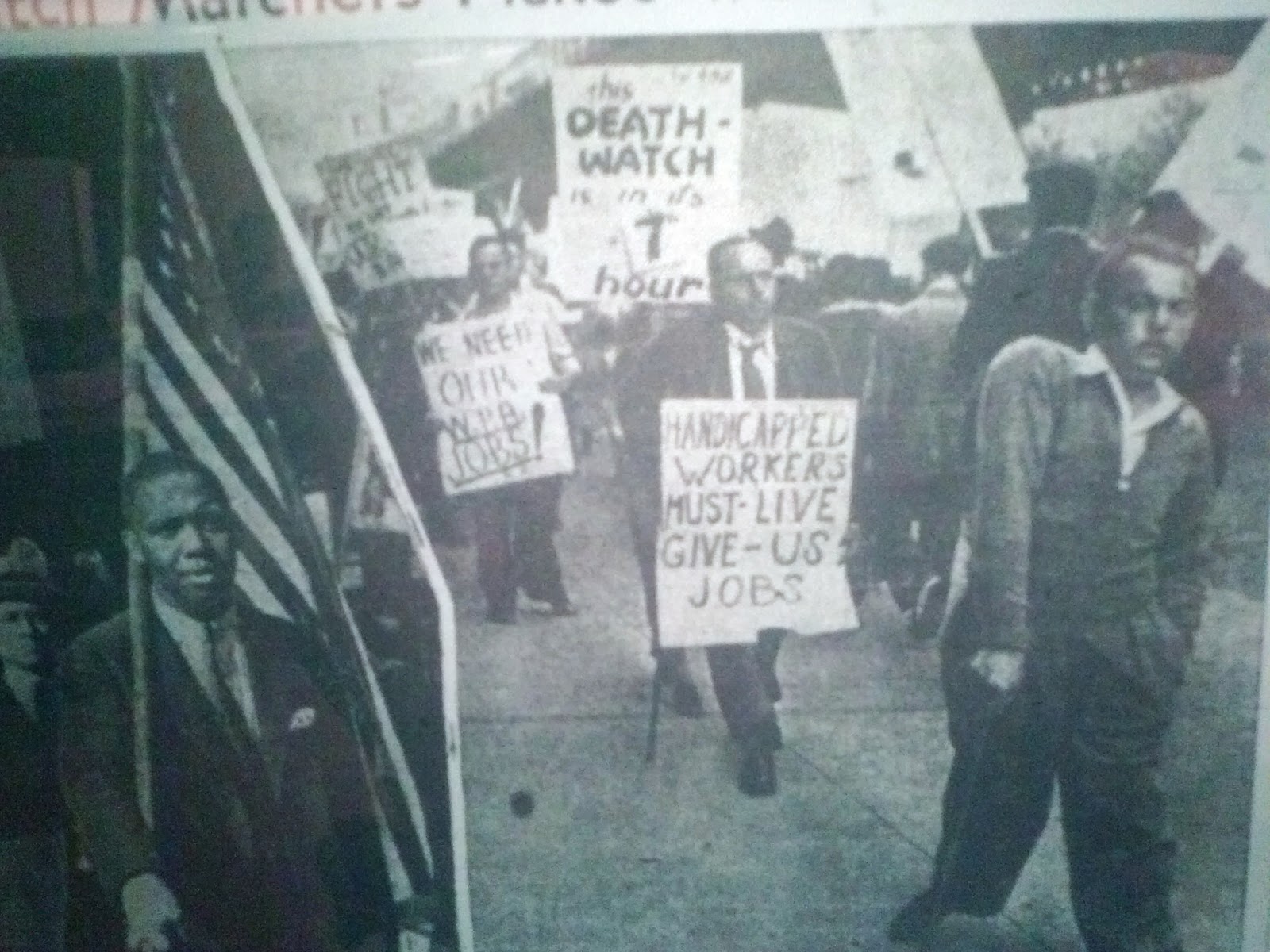
Protesting the WPA. — National Library of Medicine
Social Security Act
________________________________________________________________
8/14/1935
The Social Security Act of 1935 establishes an income maintenance system for those unable to work by providing benefits to unemployed individuals and retirees. The Act also outlines assistance to aged individuals, blind individuals, and dependent and “crippled” children, and it includes provisions for maternal and child health and welfare and the permanent function of Vocational Rehabilitation services in the United States.
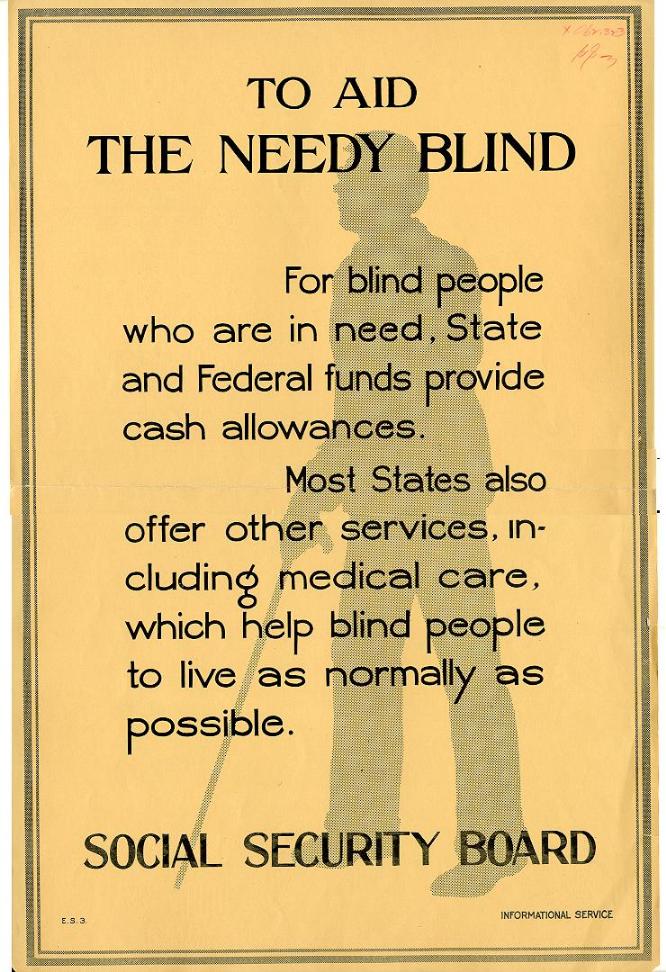
Vintage poster from the Social Security Administration advertising its benefits. — Social Security Administration
Randolph-Sheppard Act
________________________________________________________________
6/20/1936
Signed by President Franklin D. Roosevelt in 1936, the Randolph-Sheppard Act mandates a priority to people who are blind to operate vending facilities on federal property.
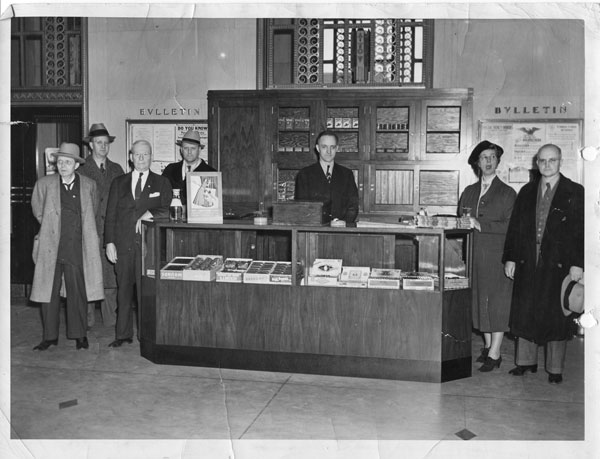
Newstand operator, c. 1940. — History of Blindness in Iowa archives
Fair Labor Standards Act Section 14(c)
________________________________________________________________
6/25/1938
The Fair Labor Standards Act (FLSA) establishes a national minimum wage. Through Section 14(c), it also allows employers, after receiving a certificate from the U.S. Department of Labor’s Wage and Hour Division, to pay subminimum wages to workers who have disabilities for the work being performed. At the time, the floor is set at 75 percent of the national minimum wage. In 1966, it is lowered to 50 percent. However, it does not apply in “work activity centers,” also known as sheltered workshops, resulting in segregated work environments for many people with disabilities. In 1986, the floor is eliminated altogether. Rather, workers are to be paid wages commensurate with their productivity based on prevailing wages.
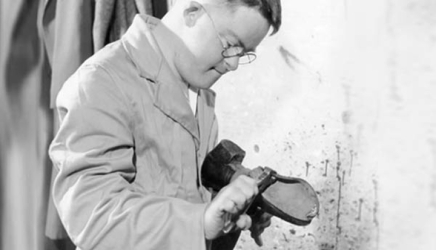
Contemporary photo of a sheltered workshop employee, c. 1966. — The Denver Post
Wagner-O’Day Act
________________________________________________________________
6/25/1938
The Wagner-O’Day Act is passed, requiring all federal agencies to purchase specified products made by people who are blind. In 1971, the Javits-Wagner O’Day Act expands the program to include services as well as supplies and incorporate people with other significant disabilities. In 2006, the program is renamed AbilityOne.

Person making brooms, c. 1940. — Lighthouse for the Blind
Declaration of “National Employ the Physically Handicapped Week”
________________________________________________________________
8/11/1945
The return of service members with disabilities from World War II sparks public interest in the contributions of people with disabilities in the workplace. On August 11, 1945, President Harry S. Truman approves a Congressional resolution declaring the first week in October “National Employ the Physically Handicapped Week.” In 1962, the word "physically" is removed to acknowledge the employment needs and contributions of individuals with all types of disabilities.
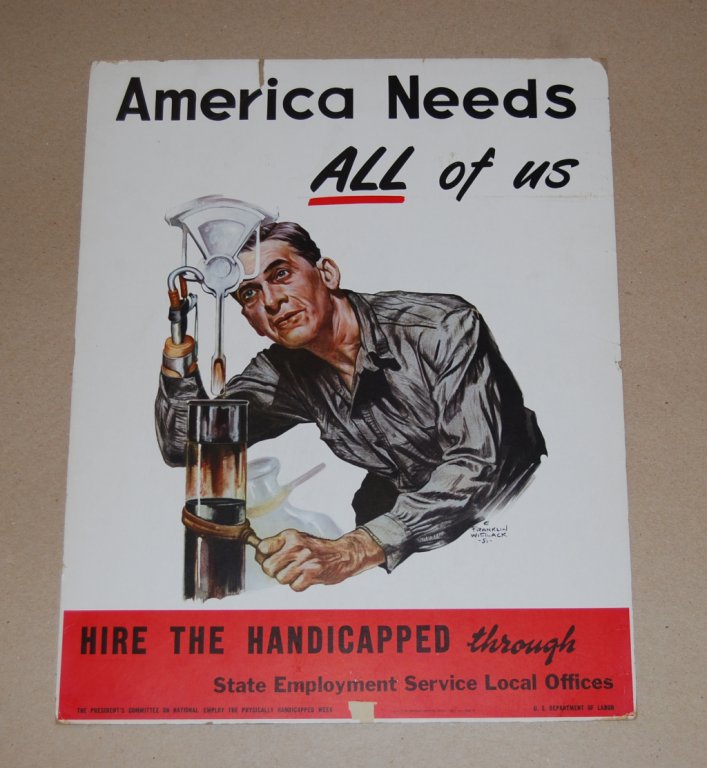
Vintage poster commissioned by the President's Committee on National Employ the Physically Handicapped Week. — National Archives
President’s Committee on “National Employ the Physically Handicapped Week”
________________________________________________________________
1947
President Harry S. Truman assembles a committee to manage “National Employ the Physically Handicapped Week.” State and local committees coordinate publicity campaigns consisting of movie trailers, billboards, and radio and television ads to convince the public that it is good business to hire people with disabilities.
"No Help Wanted." A look at the employment of people with disabilities by various industries in America during the 1940s. — National Archives
ETA Editor's Note: The referenced image is currently unavailable from the Department of Labor.
Beginning of National Barrier-Free Standards
________________________________________________________________
1950
In the 1950s, disabled veterans and other people with disabilities begin the barrier-free movement. The combined efforts of the U.S. Veterans Administration, the President's Committee on Employment of the Handicapped and the National Easter Seals Society, among others, result in the development of national standards for "barrier-free" buildings.
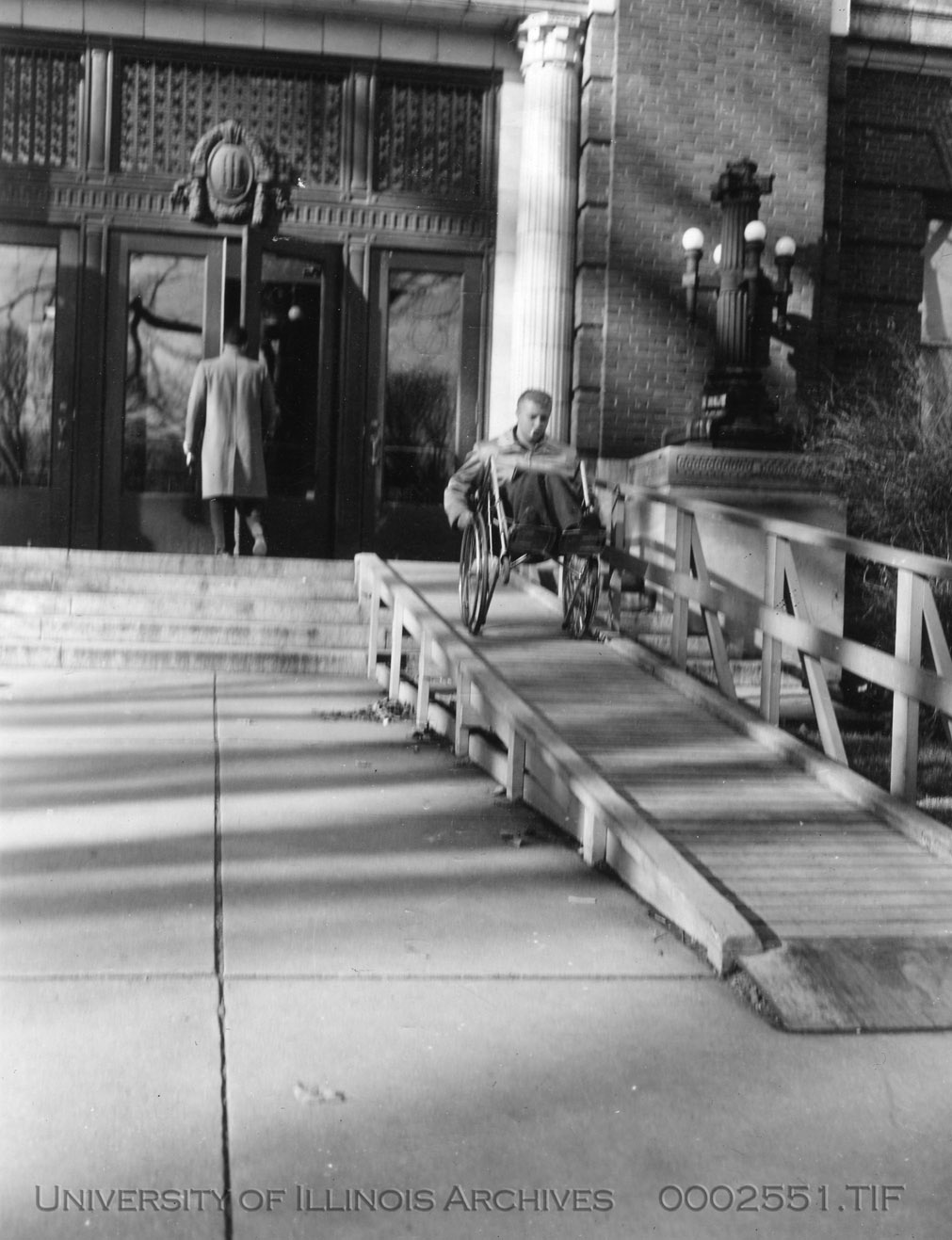
A wooden wheelchair ramp, 1952. The University of Illinois was the first university to provide wheelchair access for disabled World War II veterans. — University of Illinois
Vocational Rehabilitation Gains Momentum
________________________________________________________________
8/3/1954
Congress passes the Vocational Rehabilitation Amendments of 1954, increasing the scope of the VR system. Targeting people who could proceed or return to work with assistance, VR helps thousands of people obtain employment. Mary Switzer, Director of the Office of Vocational Rehabilitation at the time, uses this authority to fund more than 100 university-based rehabilitation programs. The Act also initiates funding for research, eventually leading to the National Institute on Disability and Rehabilitation Research.
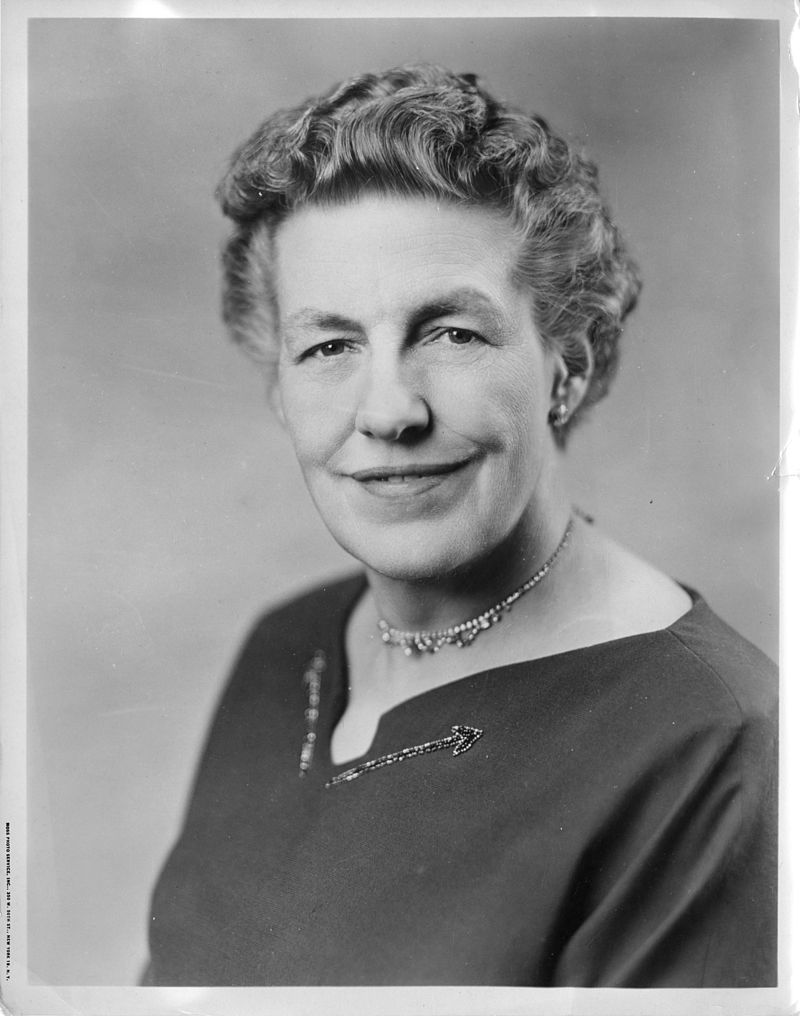
Mary Switzer — Smithsonian Institution
Creation of Social Security Disability Insurance
________________________________________________________________
8/1/1956
Congress passes the Social Security Amendments of 1956, which create a Social Security Disability Insurance (SSDI) program for workers with disabilities aged 50 to 64. Additional amendments two years later extend SSDI benefits to the dependents of workers with disabilities.
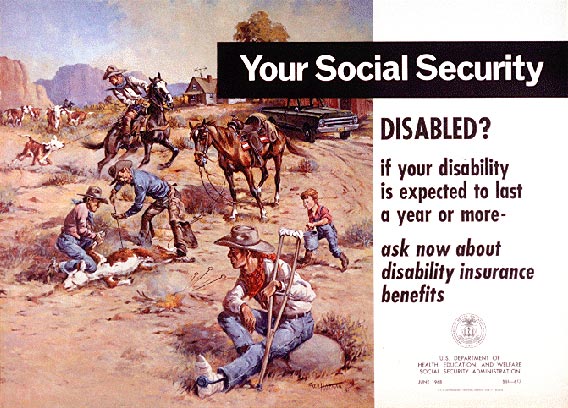
1956 poster from the U.S. Department of Health, Education and Welfare, advertising Social Security disability benefits. — National Archives
President’s Panel on Mental Retardation
________________________________________________________________
1961
President John F. Kennedy creates the President’s Panel on Mental Retardation and calls upon America to address the significant needs of people with intellectual disabilities and their desire to be a part of everyday life in America. Future administrations continue the effort, expanding its goals to include training in academic, vocational and social skills to enable children with intellectual disabilities to reach their potential. In 2003, President George W. Bush renames the committee the “President’s Committee for People with Intellectual Disabilities.”
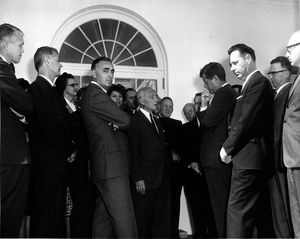
A 1961 photo showing JFK visiting at the White House with members of the President's Panel on Mental Retardation. — John F. Kennedy Presidential Library and Museum
Architectural Barriers Act
________________________________________________________________
1968
The Architectural Barriers Act mandates the removal of what is perceived to be the most significant obstacle to employment for people with disabilities—the physical design of the buildings and facilities—by requiring that all buildings designed, constructed, altered or leased with federal funds be made accessible.
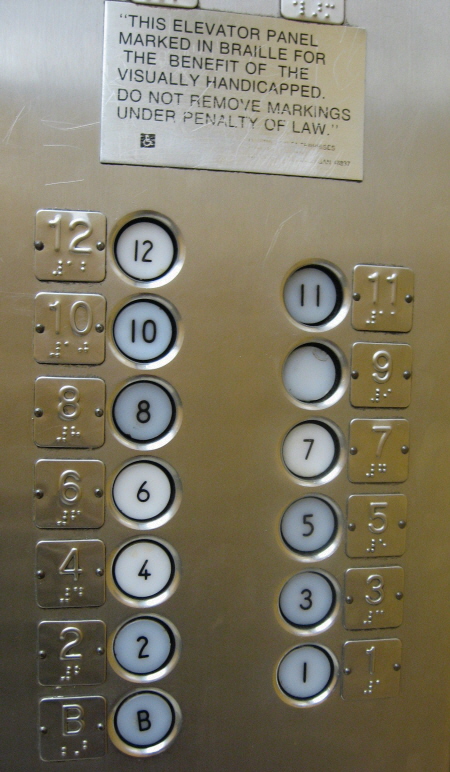
Elevator with braille signage. — Wikipedia
Independent Living Movement
________________________________________________________________
1972
Ed Roberts and other University of California, Berkeley, students found the Berkeley Center for Independent Living. The concept—an advocacy and service organization governed by and for people with disabilities—is revolutionary at the time. Related are efforts by other groups to protest President Richard Nixon’s veto of early versions of the Rehabilitation Act. Together, these actions garner national attention around issues facing people with disabilities, including employment and employment supports, including transportation.
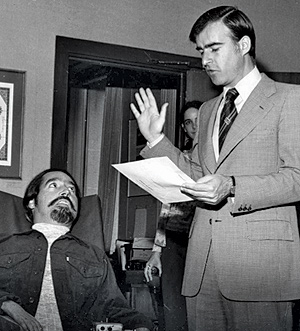
Governor Jerry Brown swears Ed Roberts in as director of the California Department of Rehabilitation in 1975. — Oakland, California, Metropolitan Transportation Commission
The Rehabilitation Act
________________________________________________________________
9/26/1973
The Rehabilitation Act of 1973 marks a major step forward in legislation impacting the employment of people with disabilities, extending and revising state Vocational Rehabilitation services and prohibiting discrimination on the basis of disability by federally funded and assisted programs, federal employers and federal contractors.
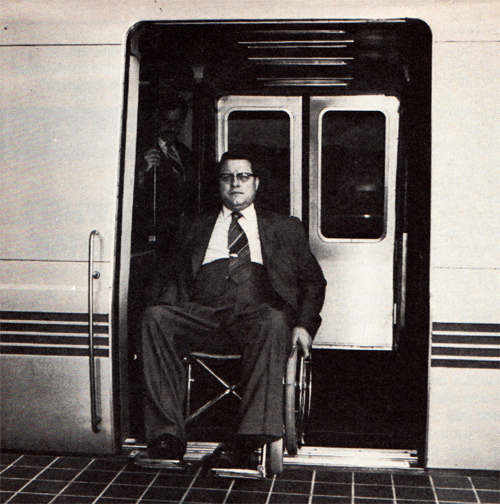
Commuting to work, c. 1970. — Kaiser Permanente Historical Archives
Education for All Handicapped Children Act/Individuals with Disabilities Education Act
________________________________________________________________
11/30/1975
President Ford signs the Education for All Handicapped Children Act (EAHCA), which requires public schools to provide a “free appropriate public education” to all students, including those with disabilities. The Act is renamed the Individuals with Disabilities Education Act (IDEA) in 1990, and amendments in 1997 add a focus on transition outcomes for students with disabilities exiting high school and pursuing post-secondary options, including employment.
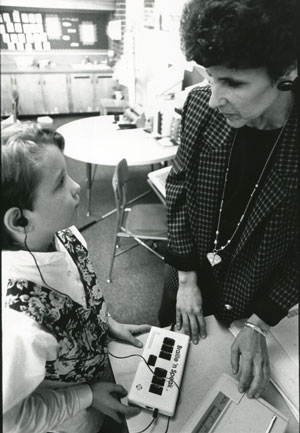
A student with visual impairment and her teacher, c. 1970s. — History of Blindness in Iowa archives
Section 504 of Rehabilitation Act
________________________________________________________________
4/28/1977
After major demonstrations in 10 U.S. cities on April 5, including a 150-person sit-in in San Francisco led by Judith Heumann and Kitty Cone lasting 28 days, U.S. Secretary of Health, Education and Welfare Joseph Califano signs regulations implementing Section 504 of the Rehabilitation Act. These regulations extend civil rights to people with disabilities, covering any program or activity, including employment services, receiving federal financial assistance.
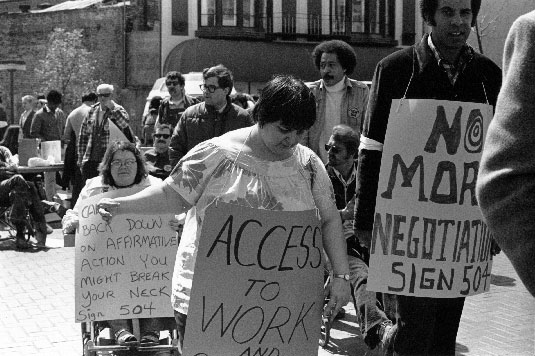
Protesters at San Francisco sit-in, c. 1977. — Anthony Tusler
“Try Another Way” and Supported Employment
________________________________________________________________
1978
The “Try Another Way” system, pioneered by special education teacher, Marc Gold, seeks to teach persons with intellectual disabilities to perform complex tasks. This provides the instructional foundation for the concept of Supported Employment, a model for people with disabilities to participate in the competitive labor market, helping them find meaningful jobs and providing ongoing support from a team of professionals.
Job Training Partnership Act of 1982
________________________________________________________________
10/13/1982
The Job Training Partnership Act of 1982 establishes federal assistance programs to prepare youth and unskilled adults for entry into the labor force and provides job training to economically disadvantaged and other individuals facing serious barriers to employment, including those with disabilities.

Workers at a bookbindery. — David Torres
Transportation as an Employment Support
________________________________________________________________
1983
Across the nation, disability advocates draw attention to the importance of transportation as a critical link to employment as well as education, recreation and all other aspects of community life. A leading player in this movement is ADAPT (originally American Disabled for Accessible Public Transit), a grassroots activist organization that takes action in cities across the United States to bring attention to barriers to transportation, with a focus on the need for lifts on buses.
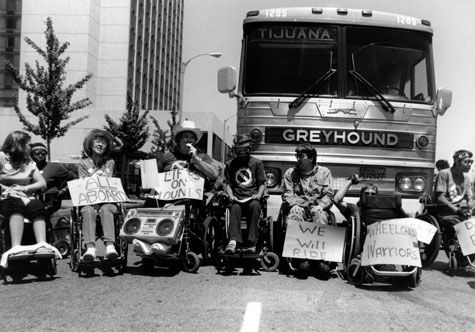
ADAPT protests Greyhound, c. 1980s. — DisabilityRights.org
Job Accommodation Network
________________________________________________________________
1983
The Job Accommodation Network (JAN) opens. This first-of-its-kind technical assistance center provides free, expert and confidential guidance on workplace accommodations and disability employment issues. The service begins with two consultants at West Virginia University providing accommodation information to employers over two telephone lines. It soon expands to serve private employers of all sizes, government agencies, employee representatives and service providers, as well as people with disabilities and their families.
— JAN
Employment Opportunities for Disabled Americans Act of 1986
________________________________________________________________
11/10/1986
The Employment Opportunities for Disabled Americans Act enhances work incentives for people with disabilities under the Supplemental Security Income (SSI) program by making permanent section 1619 of the Social Security Act, which provides for special SSI payments and Medicaid coverage while eligible individuals make attempts to work.
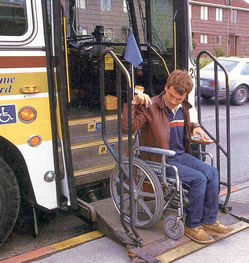
Man using wheelchair lift to access a public bus. — National Archives
President’s Committee on the Employment of People with Disabilities
________________________________________________________________
1988
The “President’s Committee on the Employment of the Handicapped” becomes the “President’s Committee on the Employment of People with Disabilities.” A year later, President George H.W. Bush appoints Justin W. Dart Jr. as its chairman. Congress also expands “National Employ the Handicapped Week” to “National Disability Employment Awareness Month,” which is recognized now each October.
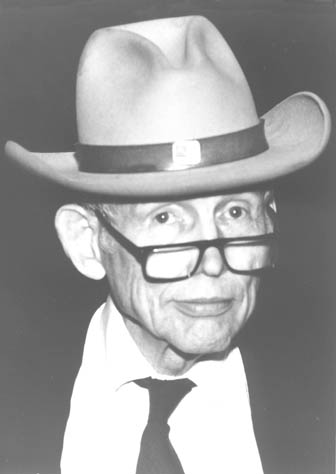
Americans with Disabilities Act
________________________________________________________________
7/26/1990
President George H. W. Bush signs the Americans with Disabilities Act (ADA) into law. Modeled on the Civil Rights Act and Section 504 of the Rehabilitation Act, the ADA stems from collective efforts by advocates in the preceding decades and is the most comprehensive disability rights legislation in history. Its employment provisions prohibit discrimination in job application procedures, hiring, advancement and termination and provide for equal access to workers’ compensation; job training; and other terms, conditions and privileges of employment.
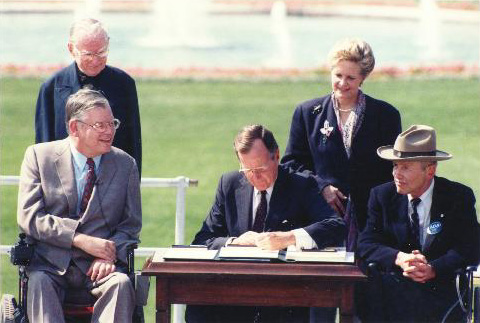
President George H.W. Bush signs the Americans with Disabilities Act, July 26, 1990. — National Archives
Rehabilitation Act Amendments
________________________________________________________________
10/29/1992
Amendments to the Rehabilitation Act emphasize employment as the primary goal of vocational rehabilitation (VR). Specifically, they mandate presumptive employability, meaning applicants should be presumed to be employable unless proven otherwise, and state that eligible individuals must be provided choice and increased control in determining VR goals and objectives, determining services, service providers and methods of service provision.

Job seeker meeting with employment service provider. — North Carolina Division of Vocational Rehabilitation
California Hosts First Youth Leadership Forum
________________________________________________________________
1992
The California Governor’s Committee for Employment of Disabled Persons holds the first Youth Leadership Forum for youth with disabilities. The U.S. Department of Labor soon begins funding other states to develop similar forums in recognition of the important role youth leadership opportunities play in promoting positive employment outcomes for youth with disabilities. By 2007, 23 states have them.
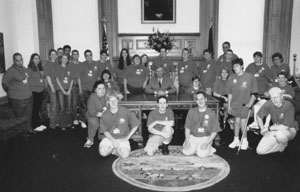
Delegates at the Forum. — California Youth Leadership Forum
Disability In the Context of Diversity
________________________________________________________________
1992
A growing number of leading businesses recognize disability as a key part of diversity and incorporate it into their workplace inclusion initiatives. Reflecting this, many join forces to establish state and local business leadership networks—groups of business leaders and human resource executives focused on increasing disability inclusion, from both an employment and consumer perspective. An umbrella organization, the U.S. Business Leadership Network, is formed to serve as the collective voice for this movement nationally.

U.S. Department of Labor employees bring their diverse perspectives to the conference table. — U.S. Department of Labor
Workforce Recruitment Program
________________________________________________________________
1995
The Workforce Recruitment Program (WRP) for College Students with Disabilities is established as a partnership between the U.S. Departments of Labor and Defense. This referral program connects public- and private-sector employers nationwide with highly motivated postsecondary students and recent graduates with disabilities who are eager to prove their talents and skills in the workplace through summer or permanent jobs.
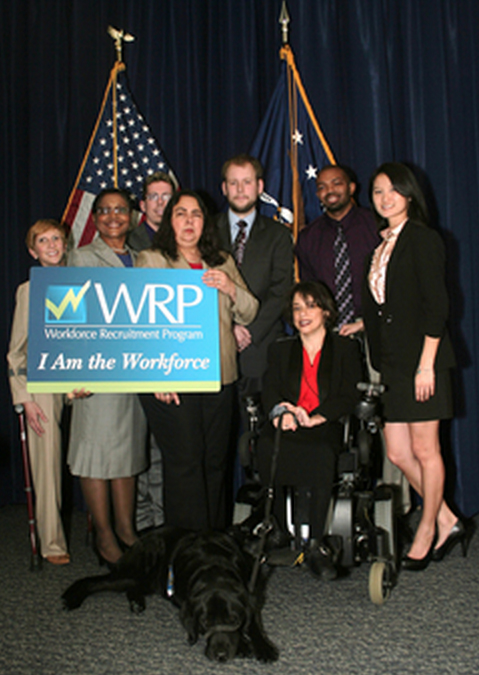
WRP alumni meet with Assistant Secretary of Labor Kathy Martinez in 2011. — U.S. Department of Labor
Telecommunications Act
________________________________________________________________
2/8/1996
This Act—the first revision of telecommunications law since the 1930s—requires telecommunications manufacturers and service providers to ensure that equipment is designed, developed and fabricated to be accessible to and usable by individuals with disabilities, if readily achievable. At its signing, President Bill Clinton addresses technology’s growing role in all aspects of life, including employment.
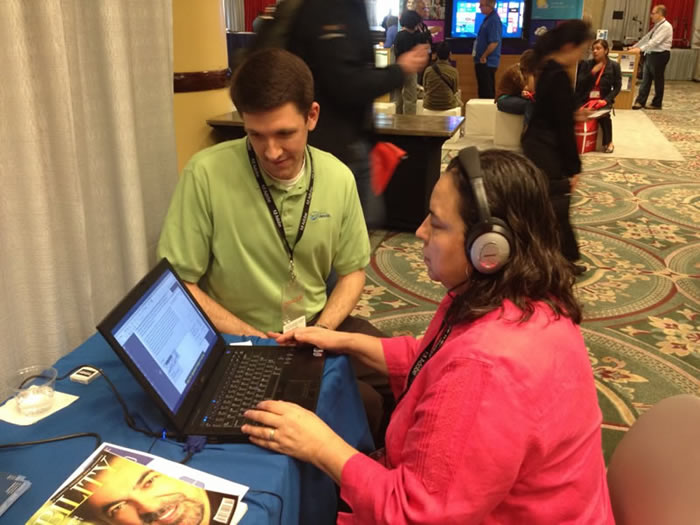
Testing adaptive equipment. — U.S. Department of Labor
Work Opportunity Tax Credit
________________________________________________________________
8/20/1996
The Small Business Job Protection Act of 1996 creates the Work Opportunity Tax Credit (WOTC) program, which provides a federal tax credit to companies that hire workers from populations that face high rates of unemployment, including people with certain disabilities.

A "Come In - We're Hiring" sign signaling a welcoming and inclusive workplace. — Thinkstock Photos
Mental Health Parity Act of 1996
________________________________________________________________
9/26/1996
President Bill Clinton signs the Mental Health Parity Act of 1996, which requires group health plans and health insurance issuers to provide annual or lifetime dollar limits on mental health benefits on par with such limits on medical and surgical benefits. It applies to employers with more than 50 employees. In 2008, the Mental Health Parity and Addiction Equity Act expands the law’s scope.

Presidential Task Force on Employment of Adults with Disabilities
________________________________________________________________
3/18/1998
Through Executive Order 13078, President Bill Clinton establishes the Presidential Task Force on Employment of Adults with Disabilities. The Task Force is directed to evaluate existing federal programs to determine the changes, modifications and innovations needed to remove barriers to employment faced by adults with disabilities. A few months later, U.S. Secretary of Labor Alexis Herman appoints Becky Ogle as its Executive Director.
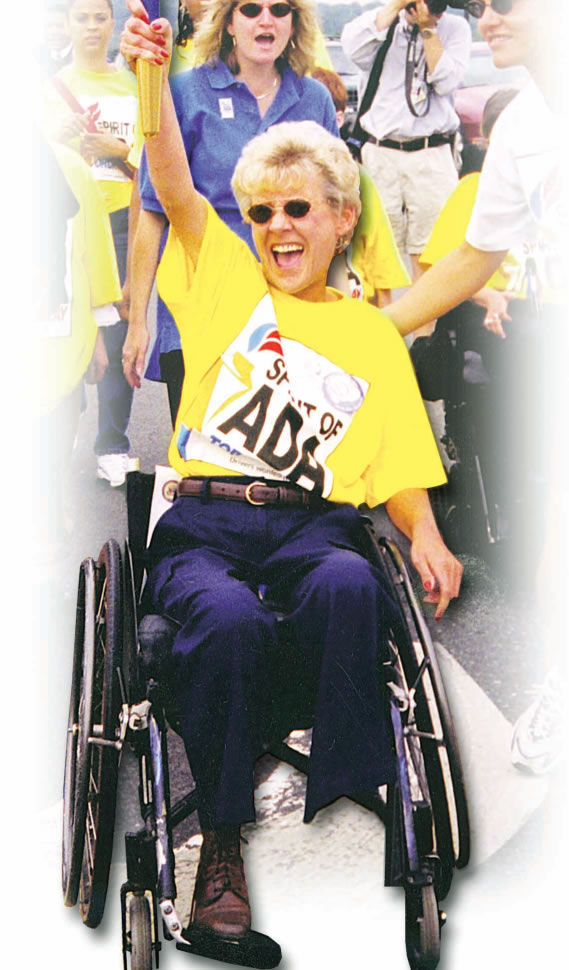
Workforce Investment Act of 1998
________________________________________________________________
8/7/1998
The Workforce Investment Act of 1998 (WIA) is passed to integrate various federal education, training and employment services for job seekers and employers. It has a number of disability-related provisions. Its Section 188 specifically mandates equal opportunity to apply for and participate in WIA-funded activities and services; it reauthorizes Rehabilitation Act programs through Fiscal Year 2003 and links them to state and local workforce development systems; and it expands Section 508 of the Rehabilitation Act to ensure that federal departments and agencies procure, use and maintain accessible electronic and information technology.

Employee using accessible technology. — The Independence Center
Section 508
________________________________________________________________
8/7/1998
Amendments to the Rehabilitation Act of 1973 require federal agencies to make their electronic and information technology accessible to people with disabilities. Under the new rules, which comprise Section 508 of the law, agencies must provide members of the public, as well as employees with disabilities, access to information comparable to that afforded those without disabilities.
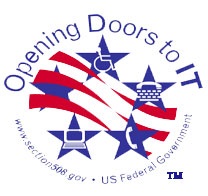
Olmstead Decision
________________________________________________________________
7/22/1999
The U.S. Supreme Court issues the landmark Olmstead v. L.C. decision, which declares segregation of people with disabilities, when integrated, community-based settings are an option, a form of discrimination under the Americans with Disabilities Act. Through this decision, the Court sends a simple, yet profound, message that long-term services and supports for people with disabilities of all ages, including participation in community living or employment, must reflect what is appropriate for and desired by the individual.

Ticket to Work and Work Incentives Improvement Act
________________________________________________________________
12/17/1999
President Bill Clinton signs the Ticket to Work and Work Incentives Improvement Act, which aims to create a more secure financial and healthcare framework so that more Social Security Disability Insurance and Supplemental Security Income beneficiaries can move toward financial independence through work without fear of losing needed supports.
Developmental Disabilities Assistance and Bill of Rights Act
________________________________________________________________
10/30/2000
The Developmental Disabilities Assistance and Bill of Rights Act of 2000 builds upon legislation from earlier decades to improve services for people with developmental disabilities in a number of areas, including employment. Specifically, its employment-related provisions support people with developmental disabilities in pursuing paid work experiences in integrated, community-based settings and acknowledge the importance of technology in increasing such opportunities.

Kirsten Davidson, clerical assistant, Consumer Products Safety Commission. You can read her story here: http://www.dol.gov/odep/profiles/KirstenDavidson.htm. — U.S. Department of Labor
Office of Disability Employment Policy
________________________________________________________________
2001
Following a 1999 recommendation from the Presidential Task Force on Employment of Adults with Disabilities, Congress establishes the Office of Disability Employment Policy (ODEP), a sub-cabinet level agency within the U.S. Department of Labor. This landmark occasion created, for the first time ever, a permanent entity to focus on disability within the context of federal labor policy.
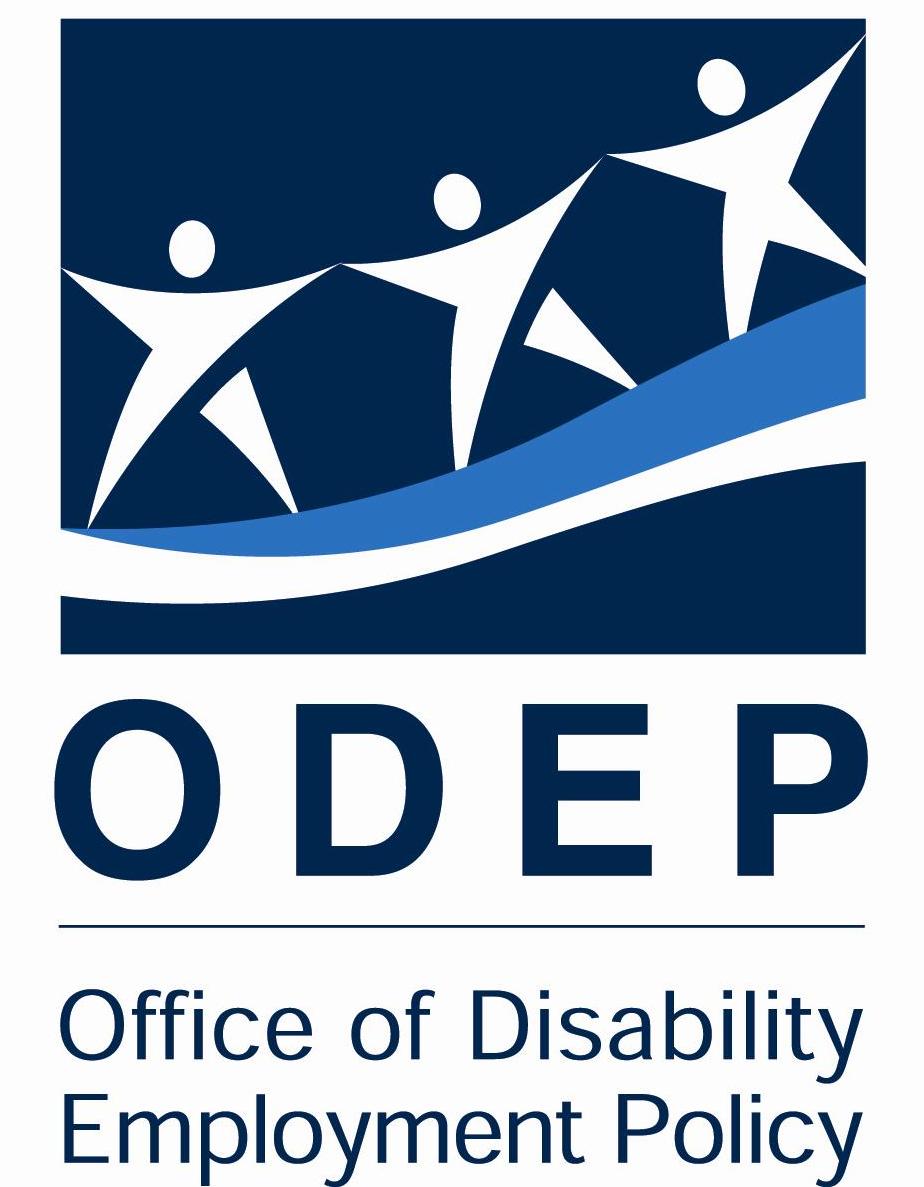
Section 508 Self-Evaluation Survey and Report
________________________________________________________________
2001
A self-evaluation survey is administered and analyzed to determine status of compliance with Section 508 of the Rehabilitation Act, which mandates that electronic and information technology administered through federal funding be accessible to all members of the public, including people with disabilities.
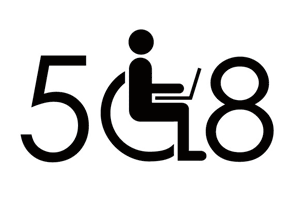
Ticket to Work Program
________________________________________________________________
2001
The Social Security Administration launches the Ticket to Work and Self-Sufficiency program—the centerpiece of the Ticket to Work and Work Incentives Improvement Act passed two years earlier. The voluntary program aims to increase the financial independence of Social Security Disability Insurance and Supplemental Security Income beneficiaries ages 18 – 64 by providing improved options for receiving employment services and maintaining publicly funded healthcare. In 2008, the regulations implementing the program are altered to revise the payment structure available to employment service providers participating in the program, called Employment Networks.
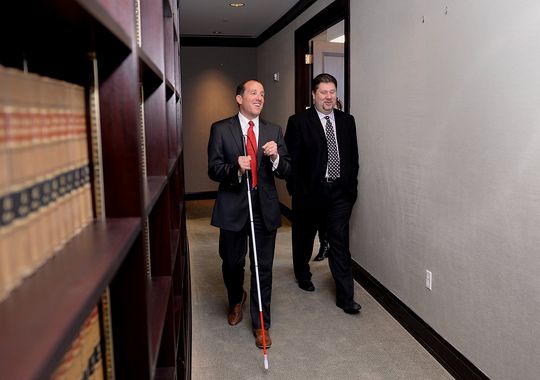
Two workers, one of whom is visually impaired and uses a cane, walking in an office. — John Minchillo
Assistive Technology Act of 2004
________________________________________________________________
10/25/2004
The Assistive Technology Act of 2004 amends previous iterations to reflect developments in technology in all aspects of community life, including employment. Among other things, it requires states to provide direct aid to people with disabilities to ensure they have access to the technology they need, at both home and work, and authorizes the development of alternative financing mechanisms to help in doing so.
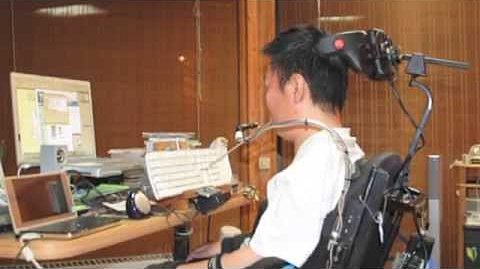
Man works from home with the aid of assistive technology. — The Independence Center
The ADA Amendments Act of 2008
________________________________________________________________
9/25/2008
The ADA Amendments Act of 2008 makes important changes to the definition of the term “disability” under the ADA, reversing previous U.S. Supreme Court decisions in favor of broad and inclusive interpretation. These changes make it easier for a person seeking protection under the law to establish eligibility under it and require courts to focus more on assessing the extent of discriminatory practices than the technical definition of the term.
Congressman Jim Sensenbrenner (R-WI) comments on The ADA Amendments Act of 2008. — National Archives
ETA Editor's Note: The referenced image is currently unavailable from the Department of Labor.
Regular Reporting of Disability Employment Statistics
________________________________________________________________
2/5/2009
The U.S. Department of Labor's Bureau of Labor Statistics adds disability to the monthly Current Population Survey (CPS), marking the first time for which official government data on the employment status of people with disabilities is available.

A Bureau of Labor Statistics web page illustrating data on the employment status of people with disabilities. — Bureau of Labor Statistics
The American Recovery and Reinvestment Act of 2009
________________________________________________________________
2/17/2009
The American Recovery and Reinvestment Act of 2009 substantially increases funding for the Individuals with Disabilities Education Act and provides more than $500 million for vocational rehabilitation services, including job training, education and placement.

President Barack Obama signs The American Recovery and Reinvestment Act. — Wikipedia
Campaign for Disability Employment
________________________________________________________________
9/18/2009
The Campaign for Disability Employment is launched. Funded by the U.S. Department of Labor’s Office of Disability Employment Policy, this multi-organization initiative uses positive messages and images to encourage employers and others to recognize the value and talent people with disabilities bring to America’s workplaces and economy. The centerpiece of the campaign is the “I Can” public service announcement, which receives significant airings on television and radio stations nationwide.
2009 Public Service Announcement. — The Campaign for Disability Employment
ETA Editor's Note: The referenced image is currently unavailable from the Department of Labor.
Executive Order 13548—Increasing Federal Employment of Individuals with Disabilities
________________________________________________________________
7/26/2010
On the 20th anniversary of the signing of the Americans with Disabilities Act, President Barack Obama signs Executive Order 13548 – Increasing Federal Employment of Individuals with Disabilities. This directive calls on federal departments and agencies to increase the recruitment, hiring and retention of people with disabilities.
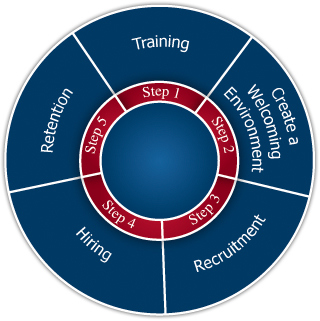
Learn how you can take the right steps toward recruiting, hiring and retaining people with disabilities in your federal workplace at http://www.dol.gov/odep/federal-hire/. — U.S. Department of Labor
Induction of Justin W. Dart Jr. and Helen Keller into Labor Hall of Honor
________________________________________________________________
7/26/2010
In celebration of the 20th anniversary of the Americans with Disabilities Act, the U.S. Department of Labor inducts disability activists Justin W. Dart Jr. and Helen Keller into the Labor Hall of Honor.
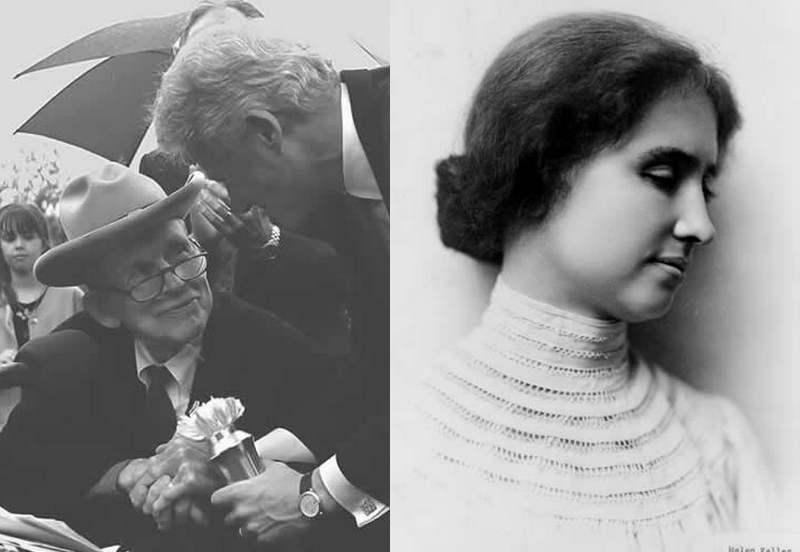
Justin W. Dart Jr. with President Bill Clinton, left; Helen Keller, right.
ADA Standards for Accessible Design
________________________________________________________________
9/15/2010
The U.S. Department of Justice publishes revised regulations for Titles II and III of the Americans with Disabilities Act. These regulations adopt revised, enforceable accessibility standards called the 2010 ADA Standards for Accessible Design, which set minimum requirements—both scoping and technical—for newly designed and constructed or altered state and local government facilities, public accommodations and commercial facilities to be readily accessible to and usable by individuals with disabilities.
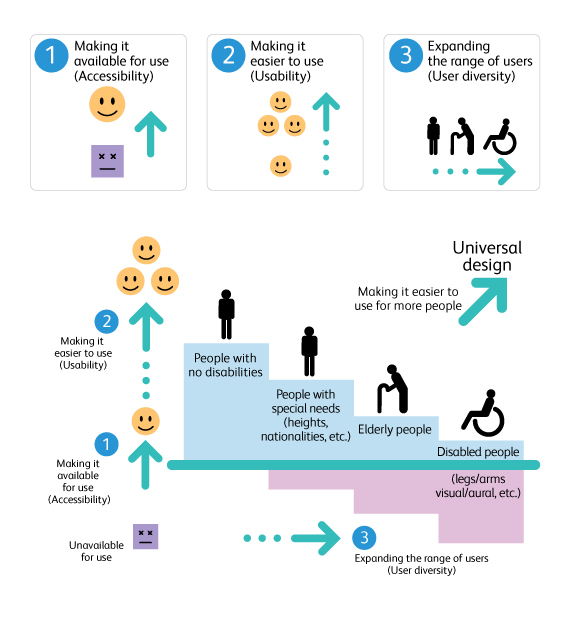
Graphic flowchart illustrating principles of universal design, which aims to make facilities, products and services accessible to the widest range of people possible. — National Association of Home Builders
Disability Employment Initiative
________________________________________________________________
9/29/2010
The U.S. Department of Labor’s Office of Disability Employment Policy and Employment and Training Administration jointly fund and administer the first round of Disability Employment Initiative cooperative agreements, providing funds to nine states to improve education, training and employment opportunities and outcomes for youth and adults with disabilities who are unemployed or receiving Social Security disability benefits.

A graduate of East Peoria High School in Illinois who has a developmental disability participates in job training. — Life Academy
Publication of Final Regulations under the Americans with Disabilities Amendments Act of 2008
________________________________________________________________
3/25/2011
The final regulations associated with The ADA Amendments Act of 2008 are approved by a bipartisan vote and published in the Federal Register. The amendments makes important changes to the definition of the term “disability” under the ADA, and make it easier for a person seeking protection under the law to establish eligibility under it.

Photo courtesy of Georgia State University. Read the Regulations under the Americans with Disabilities Amendments Act here.
Updates to Section 503 of the Rehabilitation Act
________________________________________________________________
8/27/2013
The U.S. Department of Labor’s Office of Federal Contract Compliance Programs updates regulations implementing Section 503 of the Rehabilitation Act, which prohibits federal contractors and subcontractors from discriminating in employment against people with disabilities and requires them to take affirmative action to recruit, hire, promote and retain people with disabilities. The updates strengthen these affirmative action provisions.

Read the updated regulations here: http://www.dol.gov/ofccp/regs/compliance/section503.htm.
Workforce Innovation and Opportunity Act
________________________________________________________________
7/22/2014
The first update to the nation’s workforce development system since 1998, the Workforce Innovation and Opportunity Act (WIOA) reauthorizes and amends crucial programs to help job seekers access the services they need to succeed in employment and match employers with skilled workers. The law includes a specific focus on improving employment opportunities for people with disabilities, and it sets out a number of provisions to facilitate doing so.
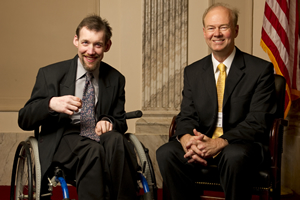
Brendan O'Neill, medical center clerk. You can read his story here: http://www.dol.gov/odep/profiles/BrendanONeill.htm. — U.S. Department of Labor
Advisory Committee on Increasing Competitive Integrated Employment for Individuals with Disabilities
________________________________________________________________
1/5/2015
The U.S. Department of Labor announces the public members of the Advisory Committee on Increasing Competitive Integrated Employment for Individuals with Disabilities—a key provision of the Workforce Innovation and Opportunity Act. Reflecting the movement toward an “Employment First” philosophy, this committee is charged with making recommendations to the Secretary of Labor on ways to increase opportunities for competitive integrated employment for individuals with disabilities. This includes recommendations on the use of, and ways to improve oversight of, section 14(c) of the Fair Labor Standards Act.
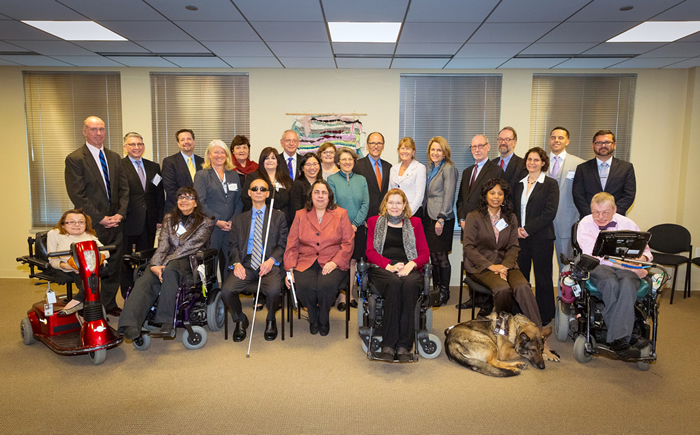
Members of the Advisory Committee on Increasing Competitive Integrated Employment for Individuals with Disabilities pose with U.S. Labor Secretary Thomas Perez. You can read about the Committee's mission and membership here: http://www.dol.gov/odep/topics/WIOA.htm. — U.S. Department of Labor

User Comments/Questions
Add Comment/Question